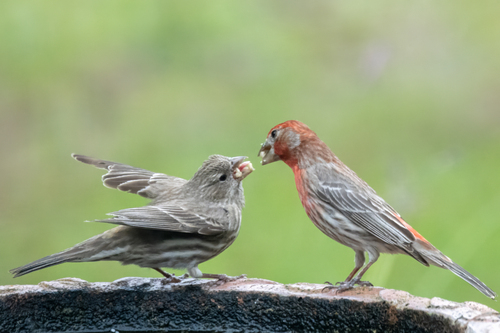
House Finch
The House Finch (Haemorhous mexicanus) is a small, lively songbird native to North America and now widespread across the continent and Hawaii. Originally found in the western United States and Mexico, it was introduced to the eastern United States in the 1940s and has since thrived, becoming a familiar sight in urban and suburban areas. House Finches play a role in seed dispersal and are known for their cheerful, warbling songs. Their adaptable nature and tolerance of human-altered landscapes have contributed to their success. While not of significant cultural importance, they are appreciated for their bright colors and lively presence.
12.5-15 cm
Length
20-25 cm
Wingspan
Least Concern
Conservation Status
Distribution
Native to the southwestern United States and Mexico. Introduced and now widespread across most of the United States, southern Canada, and much of Mexico. Also established in Hawaii.
Lifespan
Typically up to a few years in the wild; record lifespan in captivity is over 11 years.
House Finch's Habitat
Habitat Types
Urban areas, Suburban gardens, Parks, Open woodlands, Desert grasslands, Agricultural fields
Climate Zones
Temperate, Subtropical, Arid
Adaptations
Highly adaptable to various habitats, including those significantly altered by human activity. They readily use bird feeders and nest in human-made structures.
Variations
Numerous subspecies are recognized, differing slightly in plumage color and size. These variations are often subtle and reflect adaptation to local conditions.
Appearance
Breeding Plumage
Males have bright red, orange, or yellow feathers on the head, breast, and rump, especially during breeding season. Females are brown and streaky. The intensity of the male's coloration depends on diet.
Seasonal Feather Changes
Male coloration may be slightly duller in the non-breeding season.
Sex Based Plumage Differences
Significant; males are brightly colored, while females are brown and streaky.
Notable Features
Conical bill adapted for cracking seeds., Streaked brown plumage in females., Variable red, orange, or yellow coloration in males (head, breast, rump).
Diet and Feeding
Primary Foods
Seeds, Grains, Fruits, Buds
Foraging Behavior
Forages on the ground, in trees, and at bird feeders. Often feeds in small flocks.
Specializations
Strong, conical bill for efficiently cracking seeds.
Seasonal Diet Variations
May consume more insects during the breeding season to provide protein for developing chicks. Fruit consumption increases when available.
Behavior
Social Structure
Often found in pairs or small flocks. Larger flocks may form outside of the breeding season, especially at feeding sites.
Communication
Cheerful, warbling song., Variety of call notes, including a sharp "cheep".
Migration
Most populations are non-migratory or only make short-distance movements in response to food availability or weather. Some northern populations may migrate south for the winter.
Territorial or Group Behaviors
Males defend territories during the breeding season. Outside of breeding, they are generally social and tolerant of other individuals.
Conservation
Threats
Habitat loss (less significant due to adaptability), Disease (e.g., House Finch eye disease – Mycoplasmal conjunctivitis), Predation by domestic cats
Protection Programs
None specifically targeted at House Finches, but general bird conservation efforts benefit them.
Local National Laws
Protected under the Migratory Bird Treaty Act in the United States.
Population Trend
Stable
Population Estimates
Estimated global population of 260 million.
Interesting Facts
The red color of male House Finches comes from carotenoid pigments in their diet.
The brightness of the red indicates the male's foraging ability and overall health.
House Finches were illegally sold as cage birds in New York in the 1940s, leading to their introduction to the eastern United States.
They were marketed as "Hollywood Finches."
Females tend to show preference to the reddest Male.
The redder the male, the better he is at foraging, making him a better option for feeding their chicks.
Faqs about House Finch
Why are some male House Finches yellow or orange instead of red?
The color variation is due to differences in their diet. Birds consuming foods with lower levels of carotenoids will have yellow or orange plumage.
Do House Finches mate for life?
They may form pair bonds that last for a single breeding season, but they don't necessarily mate for life. New pair bonds may form each year.
What should I do if I find a baby House Finch?
The best course of action is usually to leave it alone, as the parents are likely nearby. If it is clearly injured or in immediate danger, contact a local wildlife rehabilitator. Consult a professional for medical or expert advice.
Copyright @ Nature Style Limited. All Rights Reserved.
 English
English